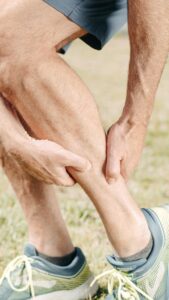The sciatic nerve is the largest nerve of the body which travels from the lower back through the hips and back along each leg while controlling muscles of the back of the knee and lower leg. Sciatica occurs when a herniated disc or a bony growth compresses the sciatic nerve. This effect of pressure on the nerve can cause inflammation, numbness, and pain in the affected leg. These abnormalities of sensation can be felt along the pathway of the sciatic nerve.
Causes for Sciatica

- Herniated disc
- Pelvic or spinal injury
- Bony prominence
- A tumor causes compression on the nerve.
- Diabetes mellitus causes inflammation in the nerve.
Risk Factors
- Age-old age people are more prone to get herniated discs which can cause sciatica.
- Obesity as it increases the weight that should be held by the spine and increases the risk of disc herniation.
- Occupations that involve lifting heavy weights and sitting for a prolonged duration of time.
- Diabetes mellitus which causes inflammation of nerves.
Clinical Features of Sciatica
- Pain along the pathway of the sciatic nerve.
- So, the pain radiates along the back, buttocks, and leg toward the feet and toes.
- The pain usually affects only one side of the body.
- Pain can be felt in various characters as numbness, tingling sensation, mild ache or sharp burning pain, or a feeling of an electric shock.
- This pain can be eased when at night when sneezing or coughing when walking for a long distance when holding breath or straining, when bending backward, and when standing or sitting.
- Movements of the affected leg might be reduced and feel a sensation of weakness.
Diagnosis of Sciatica

Initially, you will be assessed by the doctor by taking your history of pain and using a few examination techniques.
The straight leg raise test is one such test in which you feel pain in the affected limb while raising the unaffected leg for 40 degrees without bending from the knee.
A difficulty may be felt when bending the foot inward or down, when walking on toes, and when bending forward or backward. Also, the sensory examination may reveal loss of sensation and numbness.
After clinical examination, the diagnosis can be confirmed through imaging studies such as X-rays and MRIs.
Management of Sciatica
Initially, it is important to identify the cause of Sciatica and correct it. Meanwhile symptomatic management can also be achieved.
Pharmacological Management
The Mainstay of pharmacological treatment is prescribing pain killers to reduce pain as Ibuprofen and drugs to reduce inflammation of the nerve.
Injections can be given if your pain is not responding to oral drugs. These immune modulatory drugs will reduce the effect of swelling around the nerves.
Non-pharmacological Management
The application of extremes of temperature as ice or heat can also ease the pain.
Physiotherapy plays a major role in the treatment of Sciatica. You don’t need to stay on bed rest. But you need to engage in exercises that will strengthen your muscles in the back and abdomen.
Should restrain from lifting heavy weights in the first few weeks and should start exercising also after staying relaxed for a few days.
The final option is surgical management to reduce the effect of pressure on the nerve.
Prevention
- Regular exercising to ensure the strength of muscles.
- Maintaining a good posture when you are in a sitting position to maintain the normal curvature of the spine.
- When you are in a standing position or when you are lifting a heavy weight make sure the weight is distributed along the legs and not pressurized the spine. Reduce lifting heavy weights alone if you are already having symptoms as it can worsen the disease.
References
- Bailey and Love’s Short Practice of Surgery- 27th Edition
- Kumar and Clerk’s Clinical Medicine -8th Edition- Parveen Kumar, Michael Clark
- Oxford Handbook of Clinical Medicine – 10th Edition
- Browse’s Introduction to the Symptoms and Signs of Surgical Disease – 4th Edition – Norman L. Browse, John Black, Kevin G. Burnand and William E.G. Thomas

